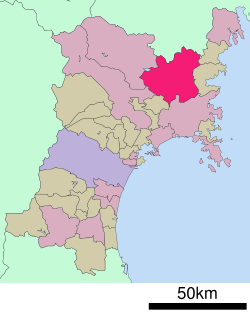Tome, Miyagi
| Tome 登米市 | |||
|---|---|---|---|
| City | |||
 upper:Swans on Hasama River middle:Japanese number one hatto Festival. Chacha world Ishikoshi lower: Korin-ji, Naganuma footopia park | |||
| |||
 Location of Tome in Miyagi Prefecture | |||
 Tome | |||
| Coordinates: 38°41′30.6″N 141°11′15.9″E / 38.691833°N 141.187750°ECoordinates: 38°41′30.6″N 141°11′15.9″E / 38.691833°N 141.187750°E | |||
| Country | Japan | ||
| Region | Tōhoku | ||
| Prefecture | Miyagi | ||
| Government | |||
| • Mayor | Takahisa Fuse | ||
| Area | |||
| • Total | 536.12 km2 (207.00 sq mi) | ||
| Population (September 2015) | |||
| • Total | 80,740 | ||
| • Density | 151/km2 (390/sq mi) | ||
| Time zone | UTC+9 (Japan Standard Time) | ||
| - Tree | Sugi | ||
| - Flower | Sakura | ||
| - Bird | Swan | ||
| Phone number | 0220-22-2111 | ||
| Address | 2-6-1 Nakae, Sanuma, Hasama-chō, Tome-shi, Miyagi-ken 987-0595 | ||
| Website | http://www.city.tome.miyagi.jp/ | ||

Tome (登米市 Tome-shi) is a city located in Miyagi Prefecture, Japan. As of 28 February 2017, the city had an estimated population of 81,434 and a population density of 151 persons per km² in 27,275 households[1]. The total area of the city is 536.12 square kilometres (207.00 sq mi). The area is noted for its rice production.
Geography
Tome is in far northeastern Miyagi Prefecture, bordered by Iwate Prefecture to the north. The Kitakami River flows through the city. The city is approximately 70 kilometers north of the prefectural capital of Sendai.
Neighboring municipalities
- Miyagi Prefecture
- Iwate Prefecture
Demographics
Per Japanese census data,[2] the population of Tome has declined over the past 40 years.
| Census Year | Population |
|---|---|
| 1970 | 102,525 |
| 1980 | 98,568 |
| 1990 | 98,231 |
| 2000 | 93,769 |
| 2010 | 83,969 |
Climate
Tome has a humid climate (Köppen climate classification Cfa) characterized by mild summers and cold winters. The average annual temperature in Tome is 11.3 °C. The average annual rainfall is 1209 mm with September as the wettest month.The temperatures are highest on average in August, at around 24.2 °C, and lowest in January, at around -0.5 °C.[3]
History
The area of present-day Tome was part of ancient Mutsu Province, and has been settled since at least the Jōmon period by the Emishi people. During the later portion of the Heian period, the area was ruled by the Northern Fujiwara. During the Sengoku period, the area was contested by various samurai clans before the area came under the control of the Date clan of Sendai Domain during the Edo period, under the Tokugawa shogunate.
The town of Tome was established on June 1, 1889 within Tome District, Miyagi with the establishment of the modern municipalities system. The modern city of Tome was established on April 1, 2005, from the merger of the towns of Hasama, Ishikoshi, Minamikata, Nakada, Toyoma, Towa, Toyosato, Tsuyama, and Yoneyama (all from Tome District, and the town of Tsuyama (from Motoyoshi District). Tome DIstrict was dissolved as a result of his merger.
2011 earthquake and tsunami
Tome was one of several cities severely affected by an earthquake and tsunami on Friday, 11 March 2011, with as many as 6,000 people left homeless.[4] On 15, 2011, authorities announced that German and Swiss teams with search dogs would be deployed to the city to aid in search and recovery efforts. Other search and rescue team came from Australia and New Zealand.[5] Early reports suggest that many residents of the nearby town of Minamisanriku, which was one of the hardest hit by the tsunami, had evacuated to Tome.[6]
Government
Tome has a mayor-council form of government with a directly elected mayor and a unicameral city legislature of 40 members.
Economy
The economy of Tome is largely based on agriculture.
Education
Tome has 21 public elementary schools, one combined public elementary/middle school, nine public junior high schools operated by the city government, and three public high schools operated by the Miyagi Prefectural Board of Education.
Transportation
Railway
- East Japan Railway Company (JR East) – Tōhoku Main Line
- East Japan Railway Company (JR East) – Kesennuma Line
Highway
- Tōhoku Expressway: (Tsukidate and Wakayanagi interchanges)
- Sanriku Expressway (Monou-Toyosato, Toyoma (Tome), Towa/Mitakido, and Monou-Tsuyama interchanges)
- National Route 45
- National Route 342
- National Route 346
- National Route 398
- National Route 456
Local attractions
Sister/friendship cities
International sister/friendship cities



Noted people from Tome
- Shotaro Ishinomori – manga artist
- Katsuhiro Otomo – manga artist
- Kouzou Sasaki – politician
- Shio Satō – manga artist
- Maruyama Gondazaemon – sumo
References
- ↑ Tome city official home page (in Japanese)
- ↑ Tome population statistics
- ↑ Tome climate data
- ↑ "Japan Tsunami victim found alive after 96 hours". tntmagazine, 15 March 2011
- ↑ "The world reaches out with funds, rescue teams". todayonline
- ↑ ABC, 13 March 2011
- ↑ "US-Japan Sister Cities by State". Asia Matters for America. Honolulu, HI: East-West Center. Retrieved 20 November 2015.
- 1 2 "International Exchange". List of Affiliation Partners within Prefectures. Council of Local Authorities for International Relations (CLAIR). Archived from the original on 22 December 2015. Retrieved 21 November 2015.
External links
| Wikimedia Commons has media related to Tome, Miyagi. |
- Official Website (in Japanese)